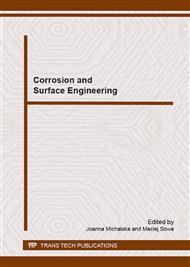p.475
p.479
p.483
p.487
p.491
p.495
p.499
p.503
p.507
Impact of Surface Modification of Ti-6Al-7Nb Alloy on Electrochemical Properties in the Environment of Artificial Blood Plasma
Abstract:
In order to improve the hemocompatibility of the Ti-6Al-7Nb alloy the study authors have proposed the modification of surface by the creation of surface layer with the application of anodic oxidation as well as sol-gel method. To verify the usefulness of the two methods and properties of created layers electrochemical testing has been proposed. Those tests have been meant to determine electrical properties that influence corrosion resistance of the alloy before and after the surface modification. Tests have been conducted with the use of measuring device equipped with PGSTAT 302n potentiostat with FRA2 attachment for impedance tests. Measurements have been taken in human blood environment simulating – artificial serum at temperature of 37 degrees Centigrade. To identify phenomenon proceeding at phases border the alloy has been additionally tested in artificial serum for 28 days. It has been found that higher voltage value (90 V) in the case of anodic oxidation has a favourable influence for electrochemical properties of the modified surface. In the case of sol-gel method, thin layer of SiO2 (some 150 nm) baked at the temperature T = 430 degrees Centigrade has the most advantageous set of electrochemical properties. Proper selection of parameters of the surface layer deposition process has a direct influence on the success of implant implantation surgery.
Info:
Periodical:
Pages:
491-494
Citation:
Online since:
January 2015
Authors:
Keywords:
Price:
Сopyright:
© 2015 Trans Tech Publications Ltd. All Rights Reserved
Share:
Citation:


